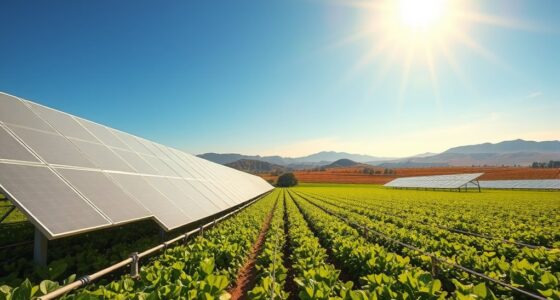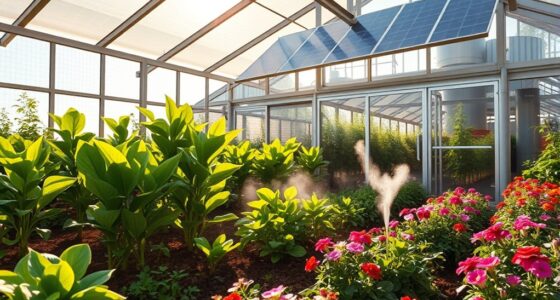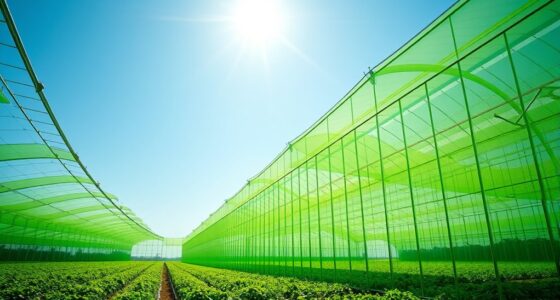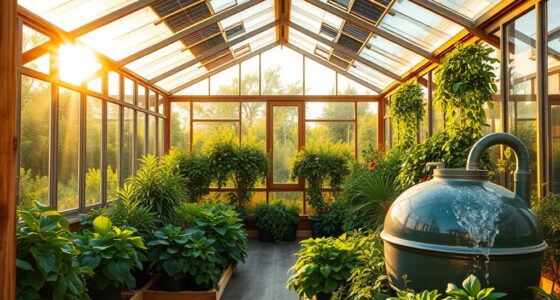Automated harvesters are transforming tomato picking by using advanced robotics and sensors that identify the ripest, highest-quality fruit. These machines work quickly, precisely selecting only perfect tomatoes while avoiding damage. They reduce the need for manual labor, cutting costs and improving safety on farms. Plus, they help farms operate more sustainably and efficiently. If you want to learn how these innovative tools are reshaping agriculture, there’s more to explore ahead.
Key Takeaways
- Automated harvesters use advanced sensors and vision systems to identify ripe tomatoes for selective picking.
- These robots reduce damage to fruit, ensuring only high-quality tomatoes are harvested.
- They lower labor costs and increase efficiency by automating the harvesting process.
- Enhanced safety features eliminate risks associated with manual labor and uneven terrain.
- Ongoing technological advancements improve precision, productivity, and the overall quality of tomato harvesting.

Have you ever wondered how farms are transforming to meet the demands of modern agriculture? The answer lies in the rise of automated harvesters, especially robots designed to pick the perfect tomato. These machines are revolutionizing the way we harvest, offering a combination of robotic precision and cost efficiency that traditional methods can’t match. With labor shortages becoming more common and wages climbing, farmers are seeking smarter solutions to keep production steady and profitable. Automated harvesters step in to fill this gap, reducing reliance on manual labor and minimizing human error.
Automated harvesters are transforming farms with precision and cost savings in modern agriculture.
When you think about robotic precision, it’s clear that these machines are built to perform with incredible accuracy. Equipped with advanced sensors and vision systems, they can identify ripeness levels, avoid damaged fruit, and select only the best tomatoes for harvest. This level of precision ensures higher quality produce while decreasing waste. Unlike human pickers, robots don’t tire or get distracted, so they maintain consistency throughout the entire harvest. They can work tirelessly, day and night, optimizing the timing of harvests and ensuring that tomatoes reach consumers at peak freshness.
Labor cost is a major concern for farmers, and automated harvesters provide a compelling solution. Traditional harvesting requires a large workforce, which can be expensive and unpredictable. Labor shortages, especially during peak harvest times, can delay picking and threaten crop quality. By deploying robots, farmers considerably cut down on wages and other labor-related expenses. This not only lowers costs but also improves planning and predictability, since automated systems can be scheduled and operated with minimal human oversight. Over time, the savings from reduced labor costs can be substantial, making these machines a smart investment for growers looking to enhance profitability.
Furthermore, automated harvesters contribute to improved safety on farms. Picking tomatoes involves traversing uneven terrain and handling heavy loads, which can be risky for human workers. Robots eliminate these hazards, reducing accidents and ensuring worker safety. They also help address labor shortages in regions where farm labor is scarce or costly, making farming more sustainable and resilient. Additionally, the integration of sensor technology allows these machines to adapt to changing field conditions in real-time, further increasing their efficiency.
In essence, the adoption of automated harvesters is transforming agriculture by combining robotic precision with reduced labor costs. They enable farmers to harvest more efficiently, with higher quality produce, and at a lower overall expense. As technology continues to advance, expect these robots to become even more sophisticated, further changing the landscape of modern farming. If you’re involved in agriculture, embracing robotic harvesters could be the key to staying competitive in an ever-evolving industry.
Frequently Asked Questions
How Do Robots Differentiate Ripe Tomatoes From Unripe Ones?
You might wonder how robots tell ripe tomatoes from unripe ones. They use color detection to analyze the fruit’s hue, identifying the bright red of ripe tomatoes. Machine learning helps these robots improve accuracy by recognizing subtle differences based on training data. As a result, they can efficiently select only the best tomatoes, ensuring quality and reducing waste during harvest.
What Are the Maintenance Requirements for Automated Harvesters?
You need to regularly maintain your automated harvesters by checking sensor calibration to guarantee accurate fruit detection and ripeness assessment. Keep software up to date with the latest updates for peak performance and security. Inspect mechanical parts for wear and tear, clean sensors and cameras, and perform routine diagnostics. Proper maintenance minimizes downtime, boosts efficiency, and extends the robot’s lifespan, helping you harvest the best quality tomatoes consistently.
Can Robots Handle Different Types of Tomato Plants?
You might wonder if robots can handle different types of tomato plants. With advanced robot adaptability and plant recognition capabilities, they can identify various plant traits and adjust their actions accordingly. This means they’re increasingly versatile, capable of working with different tomato varieties. By recognizing plant features, these robots optimize harvesting, ensuring they pick the right tomatoes efficiently, regardless of plant type or growth stage.
How Do Harvesters Navigate Complex or Uneven Fields?
Did you know that 65% of farmers say steering uneven fields is their biggest challenge? You’d use advanced soil sensors to assess terrain conditions and enable robots to adapt quickly. These harvesters rely on terrain adaptation technology, allowing them to maneuver complex, uneven fields smoothly. This guarantees efficient harvesting without damaging plants, even in tricky environments, making automation a game-changer for modern agriculture.
What Is the Cost Comparison Between Manual and Robotic Harvesting?
You’ll find that manual harvesting often costs less upfront but incurs ongoing labor expenses, affecting the labor market and economy. Robotic harvesters have higher initial costs but reduce labor dependency, potentially lowering long-term expenses. This shift impacts employment opportunities and economic stability, as automation can replace seasonal jobs. Consider both immediate costs and long-term effects on the economy and labor market when comparing manual versus robotic harvesting methods.
Conclusion
As you watch these robots dance through fields like skilled performers, it’s clear they’re rewriting the story of harvest. With precision as their brush and technology as their palette, they paint a future where crops are gathered with effortless grace. These automated harvesters aren’t just machines—they’re symphonies of innovation, transforming the landscape of agriculture. Embrace this evolution, for it promises a harvest as bountiful and beautiful as a well-tuned masterpiece.










